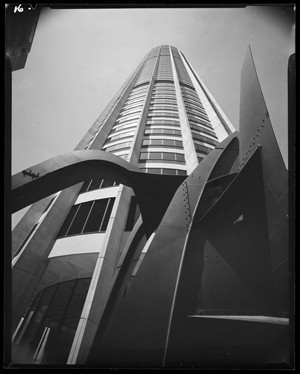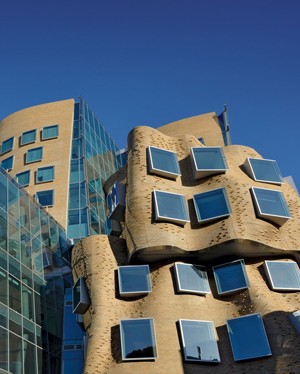Sam Spurr is a theorist and designer working across multiple modes of practice, including architecture, academia, writing and curatorship. She is currently a senior lecturer at UNSW Art and Design and a research fellow in architecture at the University of Adelaide.
Spurr is also part of N Collective, a curatorial collective founded in 2010 by Spurr, David Burns and Adrian Lahoud which creates non-institutional interactions related to art and architecture through events and forums.
Architecture & Design spoke to her about N Collective and the relationship between art and architecture and spatial design.
Can you tell A&D about Conversations curated by N Collective? What is it and how did it come about?
N is a collective formed around developing what we call ‘typologies of conversation’. We’re interested in how different kinds of conversations can create new kinds of public engagement and new kinds of communities.
It’s important to say that a conversation can occur in many forms – it can range in scales from a discussion between friends to a public roundtable in the town hall, but it can also be a conversation through a project. Designers, architects and artists are very eloquent through their different mediums, and we like to experiment with the diverse ways these disciplines share ideas.
For us it all started with dismay at the lack of critical public discussion around architecture and art. From here we started organizing projects which were showed at the Prague Quadrennial and the Gwangju Design Beinnale, as well as organising public interviews and roundtables where we could gather the most interesting people working here and abroad to share their ideas.
Do you think art, architecture and public art co-exist well in Australia at the moment?
They’re still seen as separate entities and in architecture particularly, the boundaries tend to be broached only in the more avant-garde conversations.
What’s interesting is that a lot of artists have been engaging in architecture in the last few years and you can see how this preoccupation with space, construction and the built environment is developing a really exciting field. I’m not saying this is entirely new. You’ve always had artists, from Donald Judd through to Robert Smithson, radically taking on the concerns of architecture.
What I think is new with artists such as Monica Sosnowska, is a serious wrestling with the more subtle and nuanced ways that architecture infects and affects people.
I think the relationship between art and public art is surprisingly unstable. The famous performance artist Chris Burden (generally remembered for crucifying himself to a Volkswagen beetle) once said: “I just make art. Public art is something else. I'm not sure its art. I think it's about a social agenda.”
While I’m not necessarily agreeing with the distinction, I think its really interesting to separate it in terms of a political and social argument. In this way N was exploring the idea that public art sits somewhere between art and architecture, perhaps mediating it.
Is art just an 'add-on' to architecture or do you think it's becoming more integrated and more important?
In the last SCAF conversation my colleague David Burns talked about the transformation historically from the way that art was used, one might controversially say, to ‘decorate’ the harsh and often brutal exteriors of modern architecture. You can see this in Sydney with the way the Caldor steel sculpture provides the exuberant and expressive element to Harry Seidler’s Australia Square tower.
His point is that now that architecture can look like the new Frank Gehry building going up at UTS at the moment. There is little need for art to take on the role of mediating the public face of architecture. This opens up some interesting conversations to be had about a more rich and integrated relationship between contemporary architecture and art, not for just signature buildings like an opera house, but generally.


Left: Australia Square Tower, with Crossed Blades by Alexander Calder in foreground, Max Dupain, 1968. Max Dupain & Associates. State Library of NSW: 7987-16 © Penelope Seidler. Right: Dr Chau Chak Wing Building by Frank Gehry. Image: Bowral Bricks
What would you like to see improved?
I’d like to see more diverse and experimental kinds of architecture in our cities and buildings that tantalise and engage people. I’m not simply talking about crazy looking buildings like what Gehry produces. I’m talking about how architecture engages people in often very subtle but very powerful ways.
We inhabit the world in a very different ways to how we have in the past. We walk through our cities mediated and augmented by our iPhones. What we see is shaped and obscured by the images that we are bombarded with online and our ability to always be ‘somewhere else’ virtually.
I think our architecture needs to reflect these changes – not simply in the banal way of ‘smart technologies’, but through critical, spatial innovation in how we experience the world around us. This is where architecture can learn from art.
Can you explain a little about what spatial design is and how it can be applied in everyday design?
Spatial design is simply a term in which diverse fields such as installation, performance, architecture, urbanism, interior and exhibition design can sit. It situates a form of creative practice that finds form in three dimensions. For me what is so exciting about spatial design is that as a relatively new field of practice it doesn’t have to submit to historic conventions or restrictions, but can be constantly remaking its own processes. It is inherently interdisciplinary, and while it uses many of the techniques of architectural practice, it is also comfortable employing cinema, scenography or even choreography.
You're a theorist, so how does that influence your approach to architecture?
Theory just means critical speculation, I do that through various mediums; essays, projects, teaching, magazine articles. I consider criticality as essential to my work as creativity, and for me that means how you understand the world as constructed culturally, politically and socially.
However, I think many people would do this without calling themselves a theorist, which has dirty connotations for many practitioners. For me the big problem is seeing theory and practice as separate entities as opposed to both working toward the same goals – making better worlds.
What building do you wish you designed ,and why?
This is a hard question and might change depending on when you asked me. I’m interested in what a building does rather than what it looks like. What I mean by that is I’m interested in how it affects you.
The building that has affected me the most, and probably also infected me in the sense I can’t let it go, is the State Library of Berlin by Hans Scharoun. For me this is a building that signalled the end of modern architecture, as it was constructed through the still frame of photography, and heralded a new understanding of architecture that was mobile, transformational and cinematic.
From the outside it looks really ungainly and unexceptional, but walking through it is like stepping through a series of unfolding and constantly multiplying spaces that entice you through the building, expanding and contracting to create these grand theatrical reading rooms as well as intimate, social spaces. This is all the complexity of contemporary life for me, the immensity and the solitude, the endless unravelling of new ideas and learning all gathered together in the experience of this building, not represented in its form but through how it effects you as you walk through its spaces.

Berlin State Library. Image: Maarten Thewissen. Source: Mimoa
The Sherman Contemporary Art Foundation (SCAF) recently hosted the first of a two-part series curated by N Collective, which moderated a conversation with special guest panellist Urtzi Grau, Principal of Fake Industries Architectural Agonism, that focused on the intersection of art, architecture and public art.
The next N Collective event will happen in the new year, but AR-MA's Trifolium can be viewed at the Sherman Contemporary Art Foundation (SCAF) at 16-20 Goodhope Street, Paddington, Sydney, until 13 December 2014.

